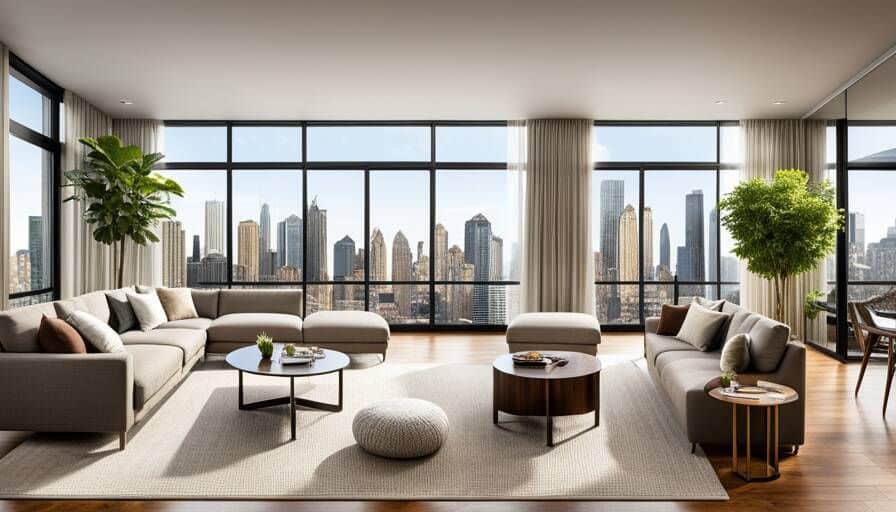Ceiling Fans for Natural Light
When it comes to enhancing natural lighting in your home, ceiling fans can be a cost-effective alternative to skylights. While they may not directly bring in sunlight like skylights do, ceiling fans have the ability to distribute natural light effectively throughout a room. By using ceiling fans strategically and pairing them with well-placed windows or other sources of natural light, you can create a brighter and more inviting atmosphere in your living space.
Ceiling fans help maximize the use of natural light by circulating it evenly. They can effectively redirect sunlight from windows or doors to different areas of a room, reducing the need for artificial lighting during daylight hours. This not only saves energy but also creates a more comfortable and pleasant environment.
For instance, imagine having a large window on one side of your living room that lets in ample sunlight. By positioning a ceiling fan on the opposite side of the room, you can use its rotation to disperse and spread that natural light across the entire space, ensuring every corner is well-lit and eliminating any dark spots.
In addition to their ability to enhance the distribution of natural light, ceiling fans offer several benefits worth considering.
- A study done by Building and Environment Journal stated that homes with skylights sometimes experience a 39% heat loss during cold months, pushing homeowners to seek alternatives.
- According to a survey conducted by the U.S Energy Information Administration, solar tubes offer 92% more light compared to traditional skylights on average, making them a popular alternative.
- Energy Star suggests that advanced window technologies may reduce energy costs by up to 15%, which has led many homeowners to opt for high-efficacy windows as an alternative to skylights.
Pros of Ceiling Fans
Ceiling fans serve multiple purposes beyond just providing cooling during hot summer months. Let’s take a look at some key advantages:
1. Energy Efficiency: Ceiling fans consume far less energy compared to airconditioning systems, making them an economical choice for both lighting and climate control needs.
2. Versatility: Ceiling fans come in a wide range of styles , sizes , and designs , allowing you to choose the perfect fit for your home decor. From sleek and modern to rustic and traditional, there’s an option available to suit every aesthetic preference.
3. Year-Round Use: Contrary to popular belief, ceiling fans also prove useful during colder seasons.By reversing their direction, ceiling fans can help circulate warm air trapped near the ceiling back down into the room, improving overall heating efficiency.
4. Quiet Operation: With advancements in technology, modern ceiling fans are designed to operate quietly, ensuring a peaceful and undisturbed environment.
5. Cost-Effective: Ceiling fans are generally more affordable compared to other lighting fixtures or cooling systems, making them an excellent long-term investment for your home.
By opting for ceiling fans as a cost-effective alternative to skylights, you can enjoy enhanced natural lighting while reaping the numerous advantages they offer.
Solar-Powered Lighting Systems
If you’re looking for a cost-effective alternative to skylights that can enhance natural lighting in your home, solar- powered lighting systems are a fantastic option to consider. These systems utilize the power of sunlight to provide illumination during the day and store excess energy for use at night. By harnessing the sun’s energy, solar-powered lighting systems help reduce reliance on traditional electricity sources, resulting in potential cost savings and environmental benefits.
One of the key advantages of solar-powered lighting systems is their versatility in installation. These systems can be installed virtually anywhere in your home where sunlight can reach, making them suitable for both interior and exterior lighting purposes. Whether it’s brightening up a dark hallway or creating an inviting ambiance in your backyard, solar-powered lighting provides an opportunity to enhance natural lighting in various areas of your home.
Solar-powered lighting systems also offer the benefit of low maintenance. Once installed, they require minimal upkeep, as they do not rely on complicated wiring or power connections. This makes them a hassle-free and convenient option, allowing you to enjoy enhanced natural lighting without the need for frequent maintenance.
Now that we’ve explored the concept of solar-powered lighting systems let’s delve into a crucial aspect that will help you make an informed decision – the cost-benefit analysis of solar lighting.
Cost-Benefit Analysis of Solar Lighting
When considering any home improvement investment, it’s important to evaluate its cost-effectiveness. In the case of solar lighting, conducting a cost-benefit analysis allows you to weigh the upfront investment against potential long-term benefits.
The initial cost associated with installing solar-powered lighting systems may vary depending on factors such as the size of your home and specific requirements. However, it’s essential to consider the long-term savings that can be achieved through reduced electricity consumption. By relying on renewable solar energy instead of traditional electric power, homeowners can potentially lower their utility bills over time.
Besides cost savings, solar lighting systems offer environmental benefits by reducing carbon emissions associated with traditional energy sources. Many homeowners appreciate the eco-friendly aspect of solar-powered lighting and prioritize sustainable choices for their homes.
For example, imagine installing solar-powered wall fixtures to illuminate your living room. While the upfront investment may be higher compared to conventional lighting, you can anticipate significant electricity savings in the long run. This can result in substantial cost savings over the lifespan of the solar lighting system.
When conducting a cost-benefit analysis, it’s crucial to consider your specific needs and expectations. Factors such as location, climate, and available sunlight should also be taken into account to determine the feasibility and potential financial advantages of solar lighting installation for your home.
Now that we have examined the cost-benefit analysis of solar lighting, let’s move on to explore another alternative to skylights – wall fixtures like sconces and others.
Wall Fixtures: Sconces and Others
When it comes to cost-effective alternatives to skylights for enhancing natural lighting in your home, wall fixtures such as sconces can be an excellent choice. Wall fixtures are lighting fixtures that are mounted on the walls and offer a stylish and functional way to illuminate a room. Sconces, in particular, come in various designs and styles, allowing you to find options that complement your home’s aesthetic.
Wall fixtures provide focused lighting and can be strategically placed throughout the room to optimize natural light distribution. By selecting fixtures with adjustable angles or diffusers, you can further enhance the lighting effects according to your preference. Additionally, wall fixtures offer the convenience of easy installation, allowing you to quickly transform any space.
Now that we have explored wall fixtures as an alternative to skylights, let’s assess their budget-friendliness.
Assessing the Budget-Friendliness of Wall Fixtures
When considering cost-effective alternatives to skylights, it is crucial to assess the budget-friendliness of wall fixtures. The overall cost will depend on various factors such as the number of fixtures needed, their quality and design, installation fees (if applicable), and any additional electrical work required.
Wall fixtures typically come in a wide price range, making them suitable for different budget levels. You can find affordable options without compromising on style or functionality. It is advisable to do some research and explore different suppliers and manufacturers to compare prices and select fixtures that meet your budgetary constraints.
Furthermore, considering the long-term benefits of wall fixtures can contribute to their budget-friendliness. Efficient LED bulbs used in these fixtures consume less energy compared to traditional ones, resulting in reduced electricity bills over time. This energy-saving feature often makes wall fixtures a more cost-effective choice in the long run.
Remember that professional consultation and installation might incur additional costs but can ensure proper placement and optimal functionality of the fixtures. Always factor in these potential expenses when budgeting for wall fixtures as an alternative to skylights.
Exploring Glass Windows and Shade Sails
When it comes to enhancing natural lighting in your home, glass windows and shade sails are two cost-effective alternatives to consider. Glass windows offer a clear and unobstructed view of the outdoors while allowing ample sunlight to filter in. By opting for large windows or even floor-to-ceiling glass panels, you can create a bright and airy atmosphere inside your home. Not only do glass windows bring in natural light, but they also provide insulation and energy efficiency, helping you reduce your reliance on artificial lighting and HVAC systems.
Imagine waking up in the morning and being greeted by a sun-filled room, with rays of golden light dancing across the floor. This not only helps elevate your mood but also reduces the need to turn on lights during the daytime. It can create a warm and inviting ambiance that connects you with nature even while indoors.
In addition to glass windows, shade sails can be a creative solution to enhance natural lighting in your home. These versatile fabric structures can be installed outside as an alternative to traditional roofing, providing shade from direct sunlight while still allowing soft diffused light to enter your space. Shade sails come in various shapes, sizes, and colors, giving you the flexibility to design a visually appealing outdoor area that meets your specific needs.
For example, you could install a shade sail over your patio or deck, creating a comfortable shaded area where you can relax outdoors without being fully exposed to the sun’s harsh rays. This setup allows a gentle glow of filtered sunlight to penetrate through the fabric, brightening up the space underneath. It’s an excellent option for homeowners who want to enjoy natural lighting without sacrificing comfort or protection from excessive heat.
By strategically incorporating both glass windows and shade sails into your home design, you can achieve an optimal balance between natural light and shade. While glass windows illuminate the interior spaces with direct sunlight during the day, shade sails offer a softer, diffused light and protect you from the intense sun when outdoors. These alternatives not only enhance the aesthetic appeal of your home but also contribute to energy efficiency and the overall well-being of its occupants.


